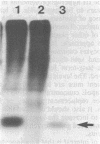Abstract
In the present study, human apolipoprotein E (apoE) was monitored in the circulation of athymic mice and rats bearing human epidermal grafts. Human apoE was detected in the systemic circulation of graft-bearing animals as long as the graft remained on the animal. Within 24 hr of graft removal, human apoE was not detectable in plasma, indicating that apoE resulted from continuous production of the protein by grafted keratinocytes. These results show that proteins as large as apoE (299 amino acids) traverse the epidermal-dermal barrier and achieve systemic distribution where they may produce effects on distal tissues. The feasibility of using grafts of genetically-altered keratinocytes for the delivery of secreted proteins is clearly reinforced by the demonstration that an epidermally derived protein exhibits systemic distribution. Finally, by virtue of its systemic distribution, apoE produced in a peripheral tissue such as skin, may function in the reverse transport of cholesterol from peripheral tissues to the liver.
Full text
PDF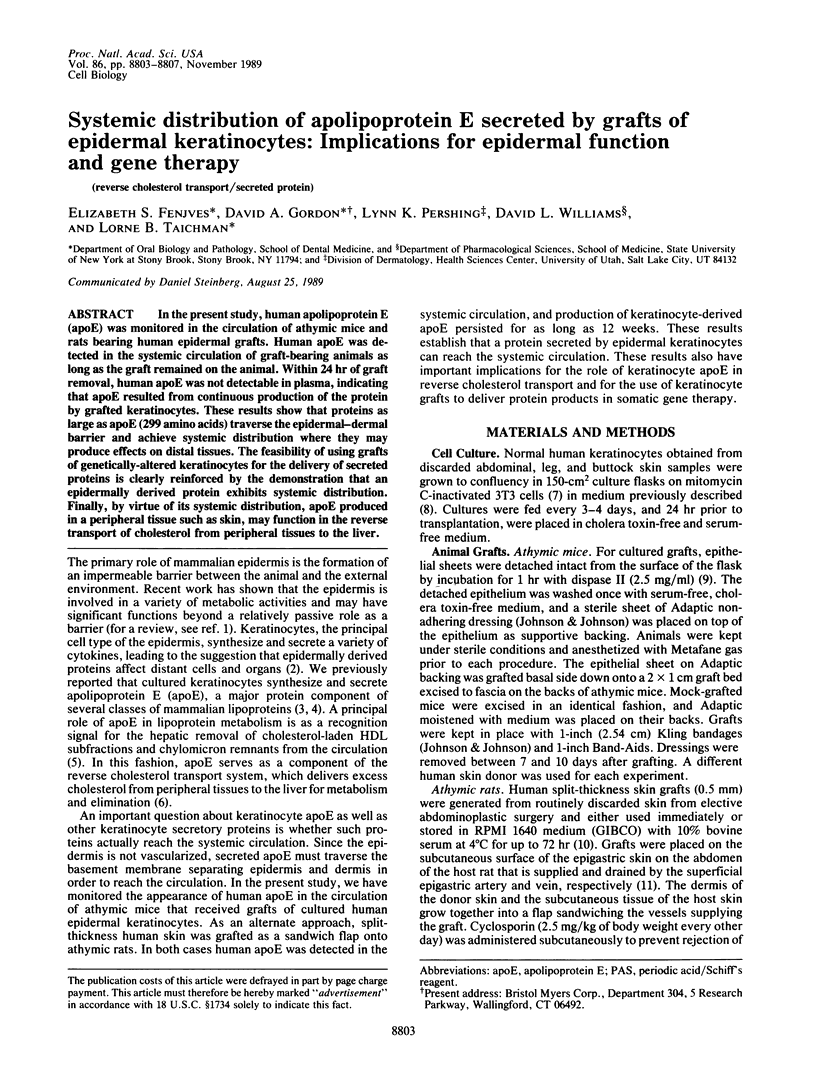
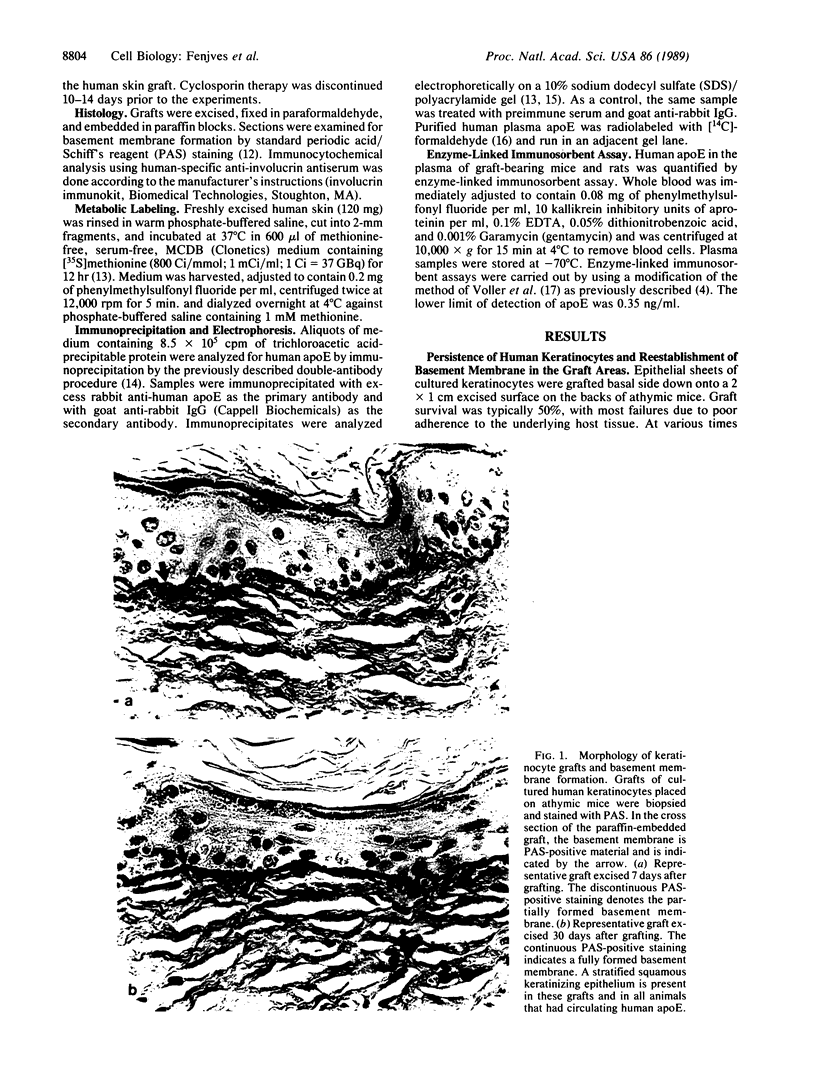
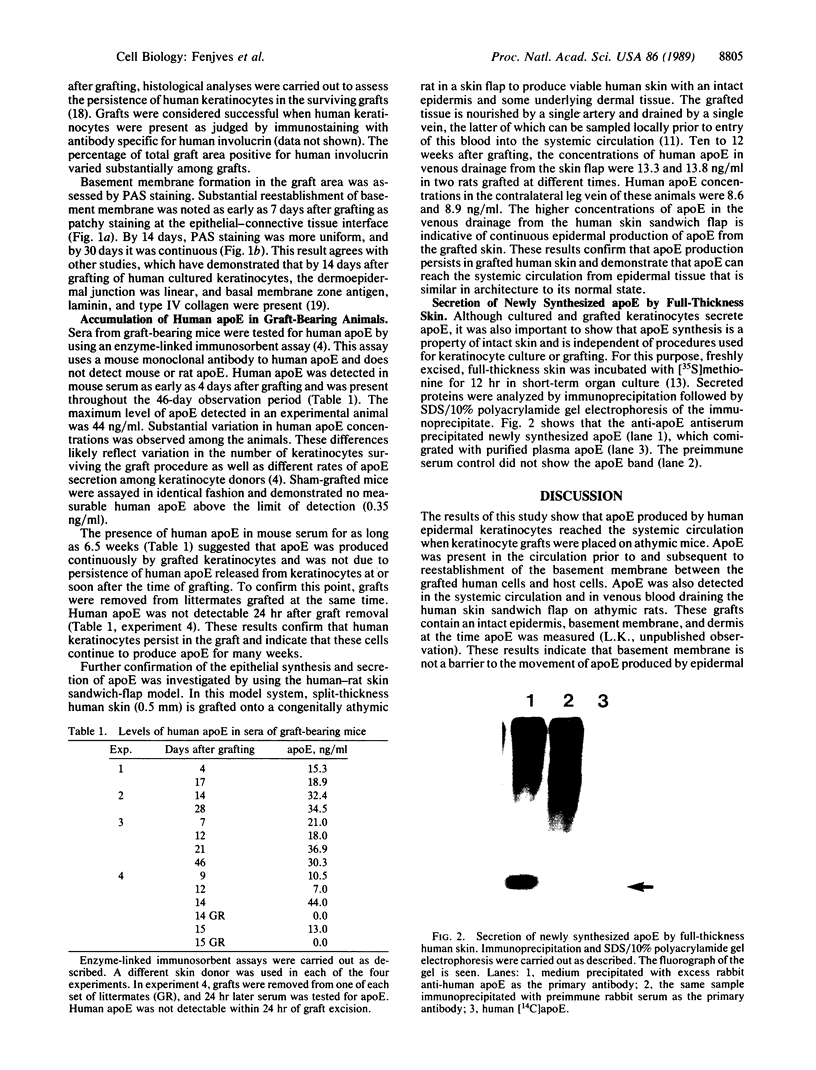
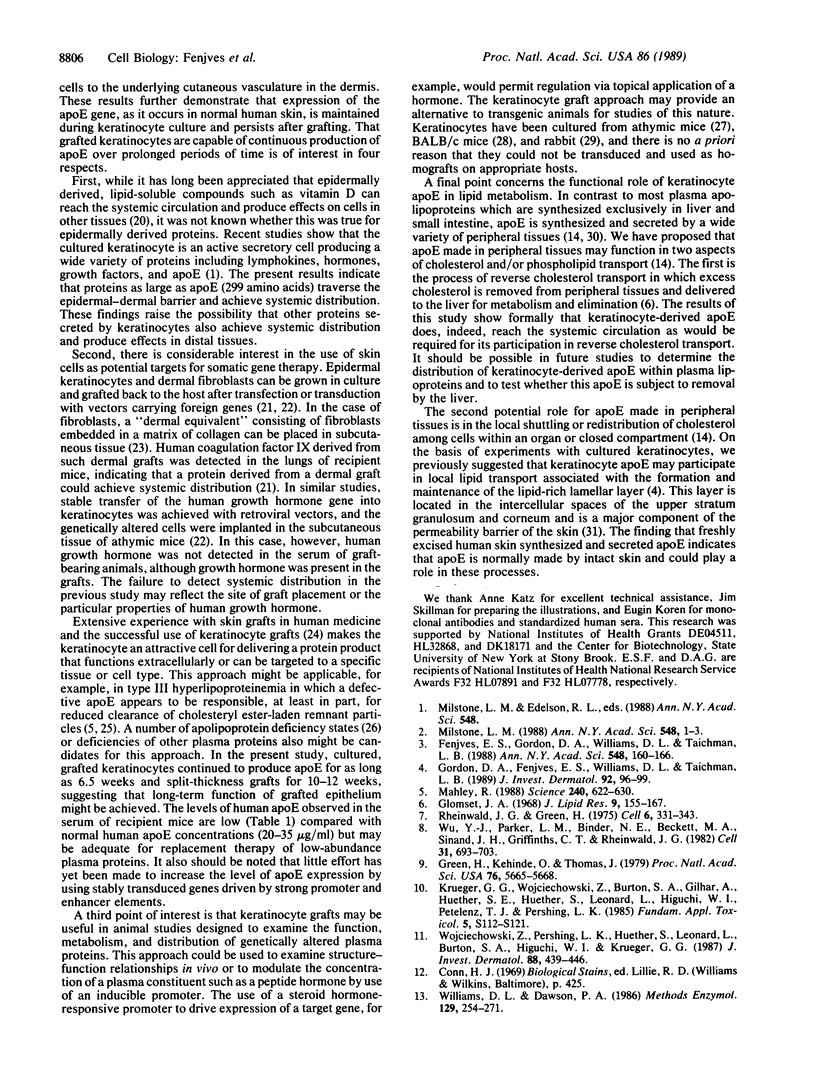
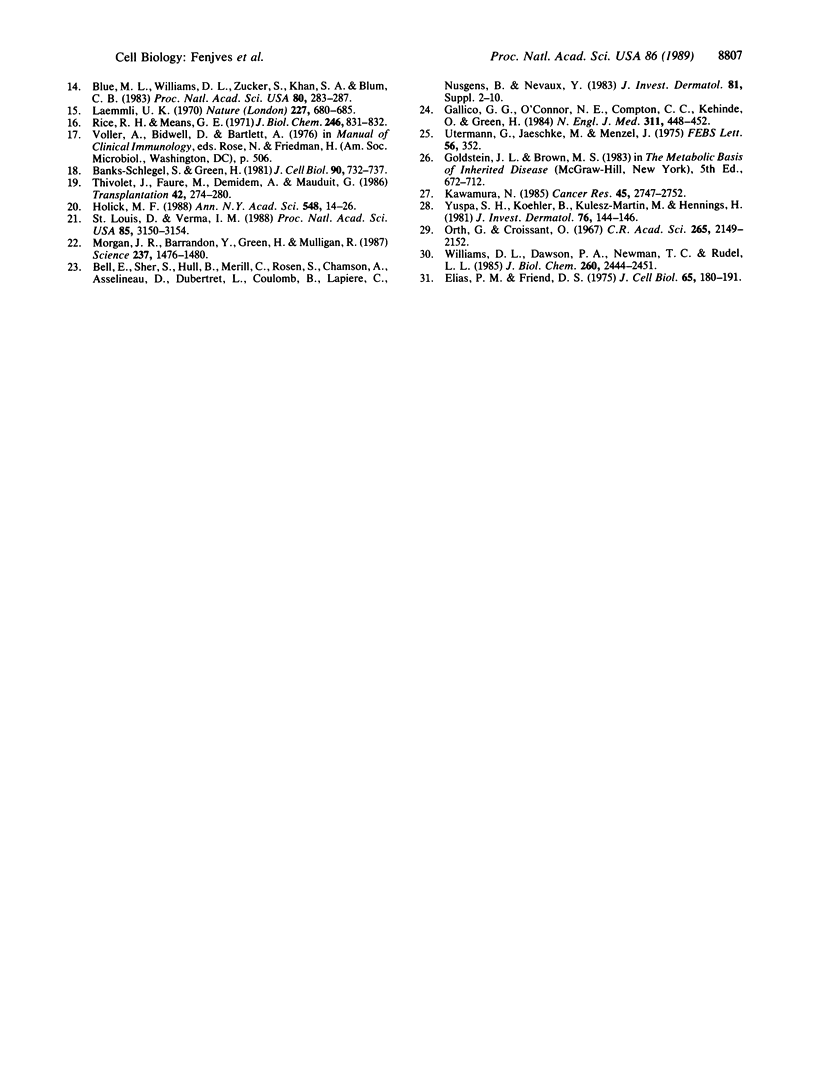
Images in this article
Selected References
These references are in PubMed. This may not be the complete list of references from this article.
- Banks-Schlegel S., Green H. Involucrin synthesis and tissue assembly by keratinocytes in natural and cultured human epithelia. J Cell Biol. 1981 Sep;90(3):732–737. doi: 10.1083/jcb.90.3.732. [DOI] [PMC free article] [PubMed] [Google Scholar]
- Blue M. L., Williams D. L., Zucker S., Khan S. A., Blum C. B. Apolipoprotein E synthesis in human kidney, adrenal gland, and liver. Proc Natl Acad Sci U S A. 1983 Jan;80(1):283–287. doi: 10.1073/pnas.80.1.283. [DOI] [PMC free article] [PubMed] [Google Scholar]
- Elias P. M., Friend D. S. The permeability barrier in mammalian epidermis. J Cell Biol. 1975 Apr;65(1):180–191. doi: 10.1083/jcb.65.1.180. [DOI] [PMC free article] [PubMed] [Google Scholar]
- Fenjves E. S., Gordon D. A., Williams D. L., Taichman L. B. Epidermal keratinocytes secrete apolipoprotein E. Ann N Y Acad Sci. 1988;548:160–166. doi: 10.1111/j.1749-6632.1988.tb18802.x. [DOI] [PubMed] [Google Scholar]
- Gallico G. G., 3rd, O'Connor N. E., Compton C. C., Kehinde O., Green H. Permanent coverage of large burn wounds with autologous cultured human epithelium. N Engl J Med. 1984 Aug 16;311(7):448–451. doi: 10.1056/NEJM198408163110706. [DOI] [PubMed] [Google Scholar]
- Glomset J. A. The plasma lecithins:cholesterol acyltransferase reaction. J Lipid Res. 1968 Mar;9(2):155–167. [PubMed] [Google Scholar]
- Gordon D. A., Fenjves E. S., Williams D. L., Taichman L. B. Synthesis and secretion of apolipoprotein E by cultured human keratinocytes. J Invest Dermatol. 1989 Jan;92(1):96–99. doi: 10.1111/1523-1747.ep13071302. [DOI] [PubMed] [Google Scholar]
- Green H., Kehinde O., Thomas J. Growth of cultured human epidermal cells into multiple epithelia suitable for grafting. Proc Natl Acad Sci U S A. 1979 Nov;76(11):5665–5668. doi: 10.1073/pnas.76.11.5665. [DOI] [PMC free article] [PubMed] [Google Scholar]
- Holick M. F. Skin: site of the synthesis of vitamin D and a target tissue for the active form, 1,25-dihydroxyvitamin D3. Ann N Y Acad Sci. 1988;548:14–26. doi: 10.1111/j.1749-6632.1988.tb18789.x. [DOI] [PubMed] [Google Scholar]
- Kawamura H., Strickland J. E., Yuspa S. H. Association of resistance to terminal differentiation with initiation of carcinogenesis in adult mouse epidermal cells. Cancer Res. 1985 Jun;45(6):2748–2752. [PubMed] [Google Scholar]
- Krueger G. G., Wojciechowski Z. J., Burton S. A., Gilhar A., Huether S. E., Leonard L. G., Rohr U. D., Petelenz T. J., Higuchi W. I., Pershing L. K. The development of a rat/human skin flap served by a defined and accessible vasculature on a congenitally athymic (nude) rat. Fundam Appl Toxicol. 1985 Dec;5(6 Pt 2):S112–S121. doi: 10.1016/0272-0590(85)90120-4. [DOI] [PubMed] [Google Scholar]
- Laemmli U. K. Cleavage of structural proteins during the assembly of the head of bacteriophage T4. Nature. 1970 Aug 15;227(5259):680–685. doi: 10.1038/227680a0. [DOI] [PubMed] [Google Scholar]
- Mahley R. W. Apolipoprotein E: cholesterol transport protein with expanding role in cell biology. Science. 1988 Apr 29;240(4852):622–630. doi: 10.1126/science.3283935. [DOI] [PubMed] [Google Scholar]
- Milstone L. M. Effector functions of epidermal keratinocytes. Ann N Y Acad Sci. 1988;548:1–3. doi: 10.1111/j.1749-6632.1988.tb18787.x. [DOI] [PubMed] [Google Scholar]
- Morgan J. R., Barrandon Y., Green H., Mulligan R. C. Expression of an exogenous growth hormone gene by transplantable human epidermal cells. Science. 1987 Sep 18;237(4821):1476–1479. doi: 10.1126/science.3629250. [DOI] [PubMed] [Google Scholar]
- Orth G., Croissant O. Caractères morphologiques et ultrastructuraux des cellules de l'epiderme de lapin adulte en culture de tsu. C R Acad Sci Hebd Seances Acad Sci D. 1967 Dec 18;265(25):2149–2152. [PubMed] [Google Scholar]
- Rheinwald J. G., Green H. Serial cultivation of strains of human epidermal keratinocytes: the formation of keratinizing colonies from single cells. Cell. 1975 Nov;6(3):331–343. doi: 10.1016/s0092-8674(75)80001-8. [DOI] [PubMed] [Google Scholar]
- Rice R. H., Means G. E. Radioactive labeling of proteins in vitro. J Biol Chem. 1971 Feb 10;246(3):831–832. [PubMed] [Google Scholar]
- St Louis D., Verma I. M. An alternative approach to somatic cell gene therapy. Proc Natl Acad Sci U S A. 1988 May;85(9):3150–3154. doi: 10.1073/pnas.85.9.3150. [DOI] [PMC free article] [PubMed] [Google Scholar]
- Thivolet J., Faure M., Demidem A., Mauduit G. Long-term survival and immunological tolerance of human epidermal allografts produced in culture. Transplantation. 1986 Sep;42(3):274–280. doi: 10.1097/00007890-198609000-00010. [DOI] [PubMed] [Google Scholar]
- Utermann G., Jaeschke M., Menzel J. Familial hyperlipoproteinemia type III: deficiency of a specific apolipoprotein (apo E-III) in the very-low-density lipoproteins. FEBS Lett. 1975 Aug 15;56(2):352–355. doi: 10.1016/0014-5793(75)81125-2. [DOI] [PubMed] [Google Scholar]
- Williams D. L., Dawson P. A. Immunochemical measurement of apolipoprotein synthesis in cell and organ culture. Methods Enzymol. 1986;129:254–271. doi: 10.1016/0076-6879(86)29074-6. [DOI] [PubMed] [Google Scholar]
- Williams D. L., Dawson P. A., Newman T. C., Rudel L. L. Apolipoprotein E synthesis in peripheral tissues of nonhuman primates. J Biol Chem. 1985 Feb 25;260(4):2444–2451. [PubMed] [Google Scholar]
- Wojciechowski Z., Pershing L. K., Huether S., Leonard L., Burton S. A., Higuchi W. I., Krueger G. G. An experimental skin sandwich flap on an independent vascular supply for the study of percutaneous absorption. J Invest Dermatol. 1987 Apr;88(4):439–446. doi: 10.1111/1523-1747.ep12469827. [DOI] [PubMed] [Google Scholar]
- Wu Y. J., Parker L. M., Binder N. E., Beckett M. A., Sinard J. H., Griffiths C. T., Rheinwald J. G. The mesothelial keratins: a new family of cytoskeletal proteins identified in cultured mesothelial cells and nonkeratinizing epithelia. Cell. 1982 Dec;31(3 Pt 2):693–703. doi: 10.1016/0092-8674(82)90324-5. [DOI] [PubMed] [Google Scholar]
- Yuspa S. H., Koehler B., Kulesz-Martin M., Hennings H. Clonal growth of mouse epidermal cells in medium with reduced calcium concentration. J Invest Dermatol. 1981 Feb;76(2):144–146. doi: 10.1111/1523-1747.ep12525490. [DOI] [PubMed] [Google Scholar]





